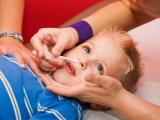Oct 20, 2009 (CIDRAP News) – Federal health officials presented more evidence today that pandemic H1N1 influenza primarily targets young people, reporting that more than half of recently hospitalized patients and close to a quarter of those who died were younger than 25.
In 4,958 hospital cases of H1N1 reported from 27 states, 53% of patients were younger than 25, while 39% were between 25 and 65, and another 7% were elderly, said Dr. Anne Schuchat, director of the National Center for Immunization and Respiratory Diseases at the Centers for Disease Control and Prevention (CDC). The data cover the period from Sep 1 to Oct 10.
"This is really, really different from what we see with seasonal influenza," Schuchat said at a news teleconference. "With seasonal flu, about 60% of hospital cases occur in people 65 and over, and here we're only seeing about 7% of hospitalizations in that age-group, illustrating that this virus is disproportionately affecting the young."
The age distribution for deaths reported in that same period was slightly older. Of 292 deaths reported from 28 states, 23.6% were in people younger than 25, while 65% involved those between 25 and 64 years of age and 11.6% involved those 65 and older, she reported.
"Again, this is dramatically different than what we see with seasonal flu," in which elderly people account for 90% of the deaths, she said.
The latest figures on hospital cases are comparable with numbers reported in a recent New England Journal of Medicine article on 272 hospital cases in May and early June. Forty-four percent of those patients were younger than 18, 50% were between 18 and 64, and 5% were older.
Vaccine supply edges upward
Meanwhile, the supply of vaccine to protect people from H1N1 continues to climb slowly, Schuchat reported. As of yesterday evening, a cumulative total of 12.8 million doses had become available, and states had ordered 10.8 million of those, she said. Those numbers compare with 9.8 million doses available and 5.8 million ordered a week ago.
The flow of H1N1 vaccine thus far has been well below earlier CDC predictions, which had envisioned the availability of 45 million doses by mid October. "I wish that we had more than we have right now, but I do want to let you know that we do have more coming out every day," Schuchat said.
More than half of the doses supplied so far are the injectable formulation, she said. The earliest doses released were the nasal spray vaccine made by MedImmune, which is approved only for healthy people aged 2 to 49 years and cannot be given to pregnant women, who are among the high-risk groups.
Schuchat said there has been "tremendous demand" for the H1N1 vaccine in many states, though reports have been mixed overall.
She also promised that more seasonal flu vaccine is on the way, amid many reports of local shortages. She reiterated previous statements that about 82 million doses have been distributed so far and that the CDC expects to see a total of about 114 million doses.
"We have seen a lot of demand for seasonal flu vaccine," she said. Calling on the public to be patient, she said supplies are likely to improve in November.
Antiviral use encouraged
Following up on guidance that the CDC issued yesterday, Schuchat made a point of urging clinicians to use antiviral drugs for suspected H1N1 patients who are severely ill or have risk factors such as pregnancy, asthma, or diabetes, or are under 2 years old.
"If you get a rapid test and it's negative, you can't really rely on that," she said. "If you suspect flu, it's very important to provide those antivirals quickly." The World Health Organization gave similar advice about antiviral use last week.
In response to a question, Schuchat said clinicians haven't been reluctant to use antivirals, but the testing is "a little bit new," and some may not recognize that a negative test doesn't necessarily rule out the infection.
She was also asked about a report suggesting that up to 60% of people infected with H1N1 will have no symptoms. She replied that the CDC is conducting serologic studies but does not yet know how many asymptomatic infections may be occurring.
"But I can say that the vast majority of people are susceptible to this infection . . . and vaccination makes a lot of sense," she said.
See also:
Oct 8 CIDRAP News story "Two reports offer new data on severe H1N1 cases"
http://www.cidrap.umn.edu/cidrap/content/influenza/swineflu/news/oct0809hospital.html
















